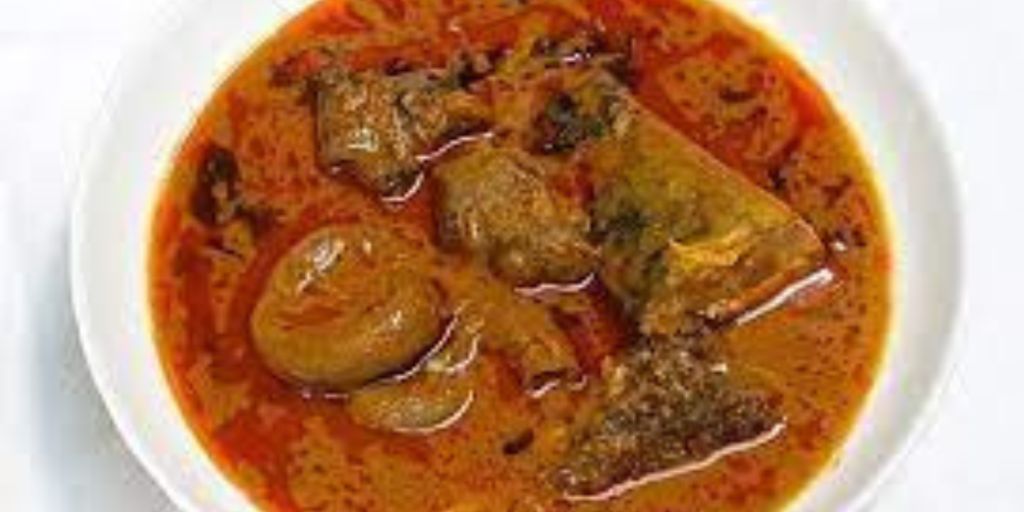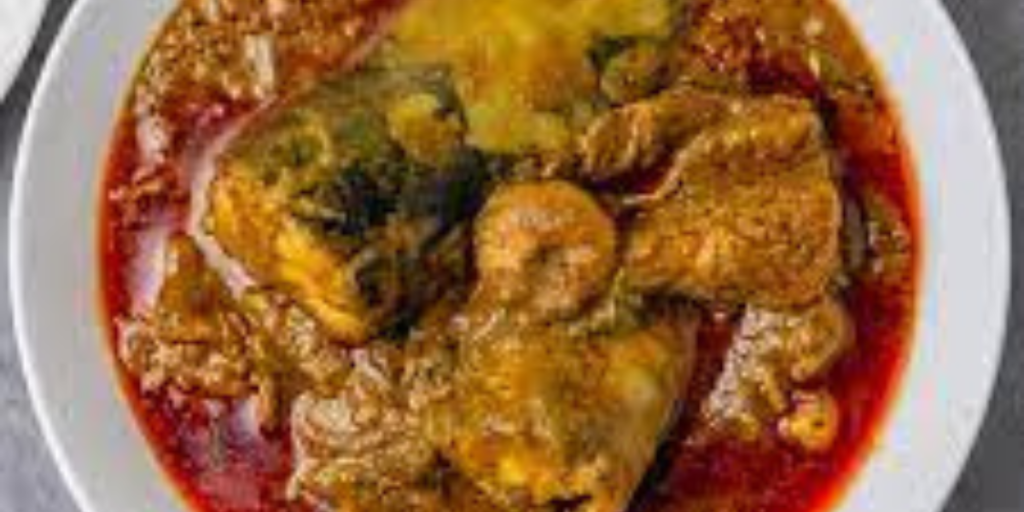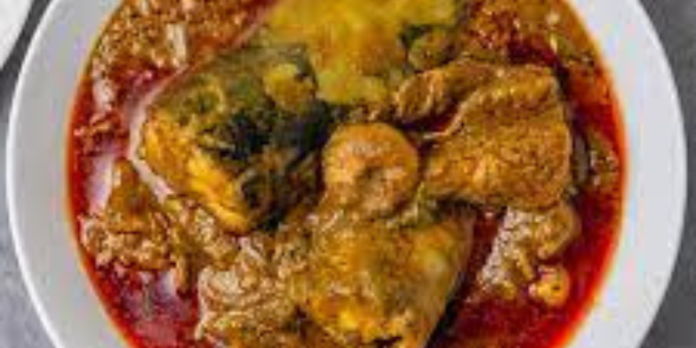Table of Contents

Banga soup, also known as palm nut soup, is a rich and flavorful dish that originates from the Delta region of Nigeria. This traditional African soup is renowned for its unique taste and texture, making it a beloved delicacy among the Urhobo, Itsekiri, and Isoko people, as well as other tribes in the Niger Delta area. The soup is primarily made from the extract of palm nuts (Banga), which imparts a distinct, savory flavor and a luscious, thick consistency. Banga soup is often enjoyed with various starchy accompaniments like pounded yam, eba, or fufu, creating a hearty and satisfying meal.
The core components of Banga soup include fresh palm nuts, assorted meats, fresh fish, and traditional spices. The preparation of this soup involves a meticulous process of extracting the palm oil from the nuts, cooking it to the right consistency, and adding an array of ingredients that enhance its flavor profile. Each ingredient plays a crucial role in defining the taste and nutritional value of the soup.
Palm nuts are the heart of Banga soup. They are boiled until soft, then pounded to extract the thick, oily pulp that forms the base of the soup. This extract is rich in healthy fats, vitamins, and minerals, making it a nutritious addition to any meal. Assorted meats and fresh fish are often added to provide protein and depth of flavor. Traditional spices such as ataiko, irugeje, and beletete leaves are used to season the soup, giving it an aromatic and slightly spicy kick.
One of the reasons Banga soup is cherished is due to its versatility and adaptability. It can be prepared with a variety of ingredients based on personal preference or availability. For instance, some variations include the use of snails, periwinkles, or dried fish, each adding a unique taste and texture to the dish. This flexibility allows Banga soup to cater to different palates and dietary needs.
The preparation of Banga soup is not just about cooking; it’s a cultural experience that brings people together. In many Nigerian households, making Banga soup is a communal activity, with family members gathering to pound the palm nuts, prepare the ingredients, and share the cooking duties. This communal aspect adds to the enjoyment and significance of the dish, making it a symbol of unity and shared heritage.
In this article, we will delve into the intricate process of making thick Banga soup, exploring its nutritional benefits, the importance of achieving the right consistency, and the best accompaniments to enjoy with this delicious dish. We will also provide some tips and variations to help you create a Banga soup that suits your taste. Whether you are a seasoned cook or a novice in the kitchen, this comprehensive guide will equip you with the knowledge and skills to make an authentic and delectable Banga soup.
Banga soup ingredients list Best of 2024
The Nutritional Value of Banga Soup

Banga soup is not only a culinary delight but also a powerhouse of nutrition. The primary ingredient, palm nut extract, is rich in essential nutrients that contribute to a balanced diet. Let’s break down the nutritional components of Banga soup:
Palm Nut Extract
Palm nuts are an excellent source of healthy fats, primarily saturated and monounsaturated fats. These fats are essential for the body as they provide energy, support cell growth, and help protect organs. Additionally, palm oil contains tocotrienols, a form of vitamin E with potent antioxidant properties that protect cells from damage and promote skin health.
The palm nut extract is also high in beta-carotene, which the body converts into vitamin A. Vitamin A is crucial for maintaining healthy vision, immune function, and skin health. The vibrant red-orange color of the palm oil is a testament to its high beta-carotene content.
Protein Sources
The assorted meats and fish added to Banga soup provide a rich source of protein. Protein is essential for building and repairing tissues, making enzymes and hormones, and supporting overall growth and development. Meats such as beef, goat, and chicken, as well as fish like catfish or mackerel, contribute essential amino acids that the body needs to function optimally.
Vegetables and Spices
Traditional spices and vegetables used in Banga soup, such as ataiko, irugeje, and beletete leaves, not only enhance the flavor but also add nutritional value. These spices are known for their medicinal properties, including anti-inflammatory and antioxidant benefits. They also provide vitamins and minerals that support overall health.
Banga Soup : Best Way to Make Banga Like a Pro in 2023
Nutritional Breakdown
A typical serving of Banga soup contains a balanced mix of macronutrients and micronutrients:
- Healthy Fats: Provide energy and support cell function.
- Protein: Essential for muscle growth and repair.
- Vitamins: Vitamin A (from beta-carotene), Vitamin E, and other vitamins from spices and vegetables.
- Minerals: Iron, magnesium, and potassium from meat, fish, and vegetables.
The combination of these nutrients makes Banga soup a wholesome and nutritious meal. Regular consumption can contribute to improved heart health, better immune function, and overall well-being.
Why Make It Thick?
The thickness of Banga soup is a defining characteristic that sets it apart from other soups. Achieving the right consistency is crucial for several reasons:
Flavor Concentration
A thick Banga soup has a concentrated flavor profile. The process of reducing the palm nut extract allows the flavors of the spices, meat, and fish to meld together, creating a rich and savory taste that is deeply satisfying. The thickness ensures that every spoonful is packed with robust flavors.
Nutritional Density
Thicker soup means more nutrients per serving. By concentrating the palm nut extract, you retain more of the healthy fats, vitamins, and minerals, making each bowl more nutritionally dense. This is particularly important for individuals who need to maximize their nutrient intake, such as children, pregnant women, and the elderly.
Improved Texture
The texture of Banga soup is an essential aspect of its appeal. A thick soup has a velvety, smooth consistency that coats the palate, providing a luxurious mouthfeel. This texture is achieved by carefully controlling the amount of liquid added and the cooking time, ensuring the soup is neither too runny nor too thick.
Versatility in Serving
Thick Banga soup pairs exceptionally well with various starchy accompaniments. Whether it’s pounded yam, eba, or fufu, the thick consistency allows the soup to cling to these starches, creating a harmonious balance of flavors and textures. This versatility makes it a favorite in many households, as it can be customized to suit different tastes and preferences.
Best 5 Nigerian Soup You Must Try In 2024
The Importance in Nigerian Cuisine
Banga soup holds a special place in Nigerian cuisine and culture. It is more than just a dish; it is a symbol of tradition, heritage, and community. Here are some reasons why Banga soup is important:
Cultural Significance
In the Niger Delta region, Banga soup is often prepared for special occasions and celebrations. It is a dish that brings families and communities together, fostering a sense of belonging and shared identity. The preparation and consumption of Banga soup are steeped in tradition, with recipes passed down through generations.
Economic Value
The ingredients used in Banga soup, particularly palm nuts, are locally sourced and play a significant role in the economy of the Niger Delta region. The cultivation and processing of palm nuts provide livelihoods for many families, contributing to the economic stability of the area. By choosing to make Banga soup, you are supporting local farmers and the economy.
Health Benefits
As previously discussed, Banga soup is a nutritious meal that offers numerous health benefits. It is a good source of healthy fats, protein, vitamins, and minerals, making it a valuable addition to a balanced diet. The traditional spices used in the soup also have medicinal properties that can support overall health and well-being.
Health Benefits of Cinnamon for Women Best of 2024
Accompaniments for Maximum Satisfaction
Banga soup is best enjoyed with a variety of starchy accompaniments that complement its rich flavors and thick consistency. Here are some popular options:
Pounded Yam
Pounded yam is a classic Nigerian dish made from boiled yam that is pounded into a smooth, stretchy dough. Its neutral taste and fluffy texture make it an ideal match for the robust flavors of Banga soup. Pounded yam absorbs the soup well, creating a satisfying and filling meal.

Eba (Garri)
Eba, also known as garri, is made from fermented and grated cassava that is reconstituted with hot water to form a dough-like consistency. Eba is slightly grainy and has a mild, tangy flavor that pairs well with the rich and savory Banga soup. It is a popular choice because it is quick and easy to prepare.
Fufu
Fufu is a staple in many West African countries, made from starchy vegetables such as cassava, yams, or plantains. It is boiled and then pounded into a smooth, elastic dough. Fufu has a mild taste and a sticky texture that allows it to pick up the thick Banga soup effectively, making each bite flavorful and enjoyable.
Starch
Starch, also known as Usi, is a thick, stretchy dough made from cassava starch. It is particularly popular in the Niger Delta region. Starch has a unique texture that enhances the eating experience, making it a perfect companion for the thick and luscious Banga soup.
Rice
For those who prefer a lighter option, Banga soup can also be served with rice. The rice soaks up the flavorful soup, creating a delicious and satisfying meal. This combination is especially popular for lunch or dinner and offers a different texture contrast compared to the traditional starchy accompaniments.
Tips and Variations for Making Banga Soup
While the traditional recipe for Banga soup is delicious on its own, there are several variations and tips that you can consider to customize the soup to your liking:
Adding Seafood
In addition to fresh fish, you can enhance the flavor of Banga soup by adding seafood such as shrimp, crab, or crayfish. These additions provide a different texture and a burst of flavor that complements the rich taste of the palm nut extract.
Using Dried Fish
Dried fish, such as stockfish or smoked fish, can add a smoky depth to Banga soup. It also provides a different texture that contrasts with the soft, succulent meats typically used in the soup.
Incorporating Vegetables
While Banga soup is traditionally made without many vegetables, you can add leafy greens such as spinach, bitterleaf, or scent leaf for added nutrition and color. These vegetables not only enhance the nutritional value but also provide a fresh, slightly bitter note that balances the richness of the soup.
Adjusting Spice Levels
The level of spiciness in Banga soup can be adjusted to suit your taste. If you prefer a milder soup, reduce the amount of chili peppers used. Conversely, if you enjoy a spicy kick, add more chili peppers or include a spicy seasoning like ground crayfish mixed with pepper.
Experimenting with Meat Varieties
While beef, goat, and chicken are commonly used, you can experiment with other meats such as lamb, oxtail, or turkey. Each type of meat adds a unique flavor and texture to the soup, allowing you to customize it to your preference.
Conclusion
Banga soup is a culinary masterpiece that embodies the rich cultural heritage and diverse flavors of the Niger Delta region in Nigeria. Its unique taste, nutritional benefits, and versatility make it a cherished dish that has stood the test of time. The meticulous process of making thick Banga soup, from extracting the palm nut pulp to combining it with assorted meats, fish, and traditional spices, results in a rich, flavorful, and satisfying meal.
The nutritional value of Banga soup, with its healthy fats, protein, vitamins, and minerals, makes it a wholesome addition to any diet. The thick consistency not only enhances the flavor concentration and texture but also ensures that each serving is nutritionally dense. Banga soup’s importance extends beyond its delicious taste; it is a symbol of tradition, community, and economic support for the Niger Delta region.
Whether enjoyed with pounded yam, eba, fufu, starch, or rice, Banga soup provides a versatile and satisfying dining experience. The variations and tips for making Banga soup allow you to customize the dish to suit your taste and preferences, making it a versatile recipe that can be adapted to different occasions and dietary needs.
In conclusion, Banga soup is more than just a dish; it is a celebration of Nigerian culinary heritage and a testament to the rich flavors and traditions of the Niger Delta. By mastering the art of making thick Banga soup, you can enjoy a nutritious, flavorful, and culturally significant meal that brings people together and nourishes the body and soul.





















